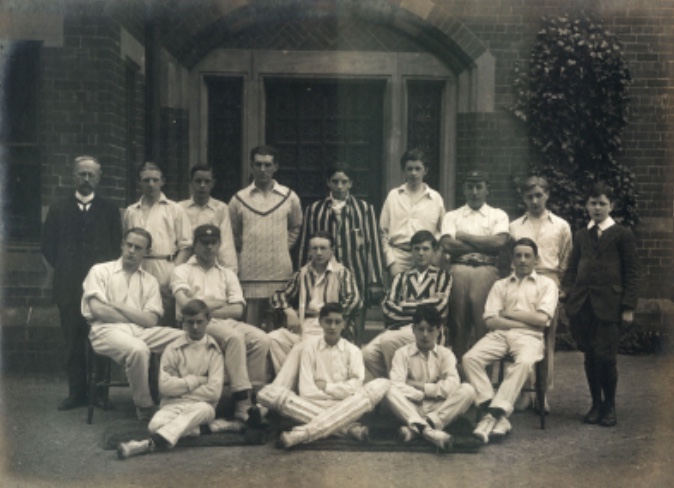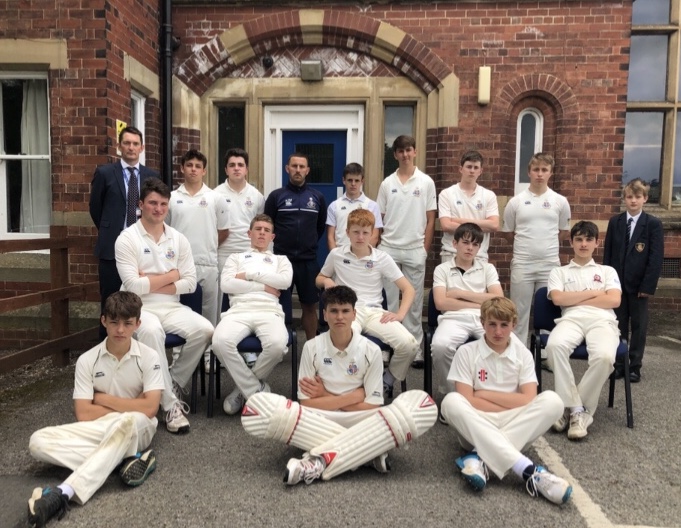Students recreate poignant WW1 photo

RIPON Grammar School's young cricketers have poignantly recreated a treasured photograph of the school's 1913 cricket team taken shortly before most of them went off to fight in the First World War, from which five never returned.

Resplendent in their whites and striped blazers, the 1913 students are pictured with their headmaster and sports masters in front of the entrance to the boys’ boarding house at Ripon Grammar School.
Taken in precisely the same spot as the original picture, the boys of today’s First XI team gathered alongside their headmaster and head of sport to pay a touching tribute to the young cricketers of more than 100 years ago, when the school only had around 90 pupils.
Thirteen boys and two young masters from the 1913 team went off to war over the next few years. The five who died were among 49 of the school’s former students and teachers killed in the conflict.
For today’s students, the moving experience has made them more determined than ever that the sacrifice these young men – and countless others like them - made will never be forgotten.
Student Oscar Lees, 16, from Ripon, commented on the 1913 photo, which shows so many young faces full of hopes and dreams for the future: “These boys who went off to fight were around the same age as us. They were very brave. It’s so important to remember them, which is what we are doing with this photograph.”
For Ben Rickard, 16, from Ripon, taking part in the recreation was a sombre experience: “It was a moment for reflection on how lucky we are today and how many great opportunities we have thanks to the sacrifice of these young men and boys.”
Bertie Woods, 15, of Brafferton, imagined the boys, glowing with youthful hope and optimism, would have been leading similar lives to him up until war broke out: “I can really relate to them. They enjoyed sport. They would have all been friends. If things had been different, that could have been me and my friends. It is a truly harrowing thought.
“Being involved in the reconstruction photo made me reflect on how ordinary yet courageous they were. I feel humbled to be able to remember them in this way.”
The school’s Old Riponians alumni society has been researching both school and national archives to bring to life the stories of these young men, putting names and background details to as many of the faces as they can as well as tracing a number of surviving relatives.
It is part of an ongoing project to remember the Fallen from Ripon Grammar School, which has unearthed many moving stories of heroism and sacrifice.
One of the young cricketers, James Jameson from Thornton-le-Dale, Pickering, was awarded the Military Cross. The Old Riponians also discovered a letter another member of the team, Samuel Cartwright from Harrogate, wrote to his old school from the Front three years before he was killed.
Current director of sport Adam Milner, 31, pictured in today’s photograph, commented: “It is harrowing to think that, born in another time, myself and all these young boys in our cricket team with such bright futures ahead of them could have been destined to go off and fight, not knowing what their future might hold.
“These students are fortunate enough to be considering university and career options as well as hopefully a bright sporting future. Standing on the very same spot as they did at Ripon Grammar School makes you realise and appreciate just what a huge sacrifice a whole generation of young men made for us.”
Headmaster Jonathan Webb emphasised that remembering the Fallen was also a commitment to work towards peace and a resolution of conflict: “It is important we continue to mark the sacrifice these young men and others like them made.”
The Old Riponians’ valuable research, he added, sheds new light on what everyday life was like for these boys at school, as well as on their war records: “During the summer of 1913 the cricket team, led by James Jameson, played 13 matches, winning six, with James leading the batting averages. But, tragically, their plans for their future were about to change and a multitude of dreams were soon shattered.”
Of the 287 former RGS pupils and teachers who fought in the First World War, about 80 per cent returned home, many of them badly injured.
In 1922, the Old Riponians purchased a field for the school in memory of those who gave their lives in the 1914-18 war, the boundary of which they marked by installing the commemorative Memorial Stone.
Old Riponians President Derek Crookes commented: "The courage shown by those who served is beyond measure and the Memorial Sports Field remains a poignant tribute to their memory."
*The five boys killed were:
Back row, fifth from left – Frederick Edmund Southwell (master)
From Filey, Yorkshire, he was classics master at RGS from 1910-1914. A lieutenant in the East Yorkshire Regiment 4th Battalion, he was killed in action on April 10, 1917, aged 27 years. Educated at St Catharine’s College, Cambridge, he was a chess blue and represented his college in every outdoor sport. He is buried at Duisans, Pas de Calais, France. His brother Wilfred was also sadly lost in the conflict.
Back row, second from right – John Stanley Morton
From Sinderby, Thirsk, he was a rifleman in the King’s Royal Rifle Corps (City of London Rifles). Reported wounded in 1916, he died on August 28, 1918, aged 22 years and is commemorated at Vis-en-Artois Memorial, Pas de Calais, France.
Second row, second from left – John Edward Tilston
From Pollockshields, Glasgow, he was a Second Lieutenant in the 154th Company, Machine Gun Corps. He was killed in action on April 23, 1917, aged 20 years and is commemorated at the Arras Memorial, Pas de Calais, France.
Second row, third from left – James Leslie Jameson
From Pickering, Yorkshire, he was a Lieutenant in the 5th West Yorkshire Regiment and was awarded the Military Cross. James died, aged 20 years, on July 2, 1916 and is commemorated at the Thiepval Memorial, The Somme, France. His brother Horace was also sadly lost in the conflict.
Second row, far right – Samuel Francis Cartwright
From Harrogate, he was a Captain in the 3rd Battalion attached to 6th Battalion, York and Lancaster Regiment, who served originally with the Royal Army Medical Corps. He returned to the Front after being wounded but was severely wounded again in the late fighting of October 1918. He died of his wounds on Tuesday, November 5, 1918, aged 22. He is buried at the British Cemetery in Sebourg, France.







